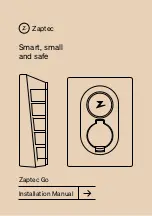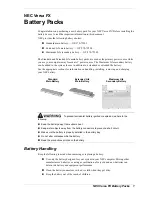
6
the conclusion that the battery is defective and has a higher
internal resistance (e.g.
because of the sulfatierung, cell damage, drainage etc.). One
can assume the same, if a discharge process in the charge/
discharge mode lasts less than 5 min.
Manually operation:
If the detected battery voltage is indicated not correctly (e.g.
the battery is deeply discharged), there is a possibility to adjust
the correct battery-voltage by hand. Following steps must be
accomplished:
. Unplug the device from the net. The LED „Netz“(main unit) is
off. . Set the slide-switches accordingly in position „500 mA“
and „Laden“ (charging). . Plug the device again to the main
unit. 4. Switch the switch „Strom“ (current) in position „000
mA“ within sec. on and off. 5. Now the LED „V“ is switched
on. 6. Set the desired battery voltage with the switch „Strom“
(current). Every switch changes the indication of the voltage
cyclically. 7. If the switch „Strom“ (current) is not operated wi-
thin 5 sec., a charging process will start. In this case it is always
charged with a current of max. 500 mA.
During the charging procedure you can make your desired set-
tings with the slide switch (charge-charge/discharge, charging
current). These settings are considered later in the automatic
operation. If the charging procedure is finished, the device
switches automatically into the automatic made.
Description of function and error analysis
After connecting
the batterys the settings of the two slide switches are rated
(see note N) and the device examines in which range lies
the battery voltage. If the one is higher than ,8V, an error is
indicated (the LEDs „Fehler“ (error) and „V“ shine). If the vol-
tage of the batteries is unstable, the LED „Fehler“ (error) flas-
hes shortly for times and at the same time the examination
of the battery voltage is repeated. If the battery voltage is in
the range between 0,5 and ,8 V and remain unit stable for
sec., the connected battery is accepted by the device and
thus charged with the selected charging current (LED „Laden“
(charge) is switched on). Here the following voltage levels are
valid for for the automatic detection 0.5... ,V (for V battery)
, .... 6.9 V (for 6 V battery) or 7.0... .8 V (for V battery),
see note „manually operation“. The battery is charged here first
with constant current, until the finalcharge-voltage (. V/cell)
is reached. Then the voltage is kept constant and the charging
current adapts to the stage of charge of the battery. The more
fully the battery is charged, the smaller is the charging current.
If the charging
current has fallen below 00 mA, he charging process is stop-
ped off and the charger switches itself automatically into the
test mode. Herby the battery is discharged with a current of
approx. 70 mA (LED „Entladen“ (discharge) is switched on). If
after 0 seconds the voltage of the battery sank below the no-
minal value (according to , 6, V), the battery is rated by the
charger as „defekt“ (defectively), (see note N) the device swit-
ches itself off and the LED „Fehler“ (error) lights up. The device
remains in this condition until the battery clamps are removed.
If the testing was however successfully, the device turns either
into the preservation mode or into the discharging mode (de-
pending upon switching position). If the device is defective,
the charging procedure is stopped and the LED „Fehler“ (error)
flashes in a pulse of 0,5 seconds,
Note!
- When charging the battery pay attention that the batteries
are connected correctly with the poles.
- In order to avoid damages to the batteries please pay attenti-
on that the batteries are never over- discharged. Ventilate the
room sufficiently.
- when charging lead acid batteries, open the cell plugs of the
lead battery. - examine acid level of the lead batteries. - exa-
mine acid level also during longer charge duration also occa-
sionally. Open, if necessary, the cell plugs of the lead batteries.
While charging a positive pressure develops in the internal of
the battery, which must be diminished. - In principle avoid
open fire, open light and sparks near the batteries just being
charged (danger of explosion by detonating gas). - attention
absolutely the charging references of the respective producer
of the batteries (usually imprinted on the battery).
Disturbance
If it is to assume that a safe operation is no longer possible, the
device is to be set out of operation and to secure against unin-
tentional operation.
That applies:
- if the device shows visible damages
- if the device is no longer functional
- if parts of the device are loose
- if the connection cables show visible damage.
- If the device must be repaired, only original spare parts may
be used! The use of other spare parts can lead to serious da-
mages and personal injuries! A repair of the device may be
done only by a specialist! If the device should not work cor-
rectly any more, we recommend to send the device back to us
where we will repair it.
Technical data
charge terminal voltage: v-batteries: . V, 6 v-batteries: 6.9 V,
v-batteries: .8 V • max. charging current:
0.5 A or A
(adjustable) • operating voltage: 0 V AC 50 Hz dimensions (L
x B x H): 0 x 70 x 45 mm weight: approx.. 475 g • scope of
supply:
inclusive battery connection clamps and manual
Technical changes subject to alterations.
No liability for
misprints This article was examined after the EEC guideline
89/6/EWG (EMVG of 09..99, electromagnetic compati-
bility) and corresponds to the legal regulations.
Guarantee
This device carries a two-year guarantee. The guarantee covers
elimination of faults free of charge which have been verifi-
ably caused by the use of deficient material or manufacturing
faults.
We reserve the right to make technical alterations. We assume
no liability for printing errors.
























